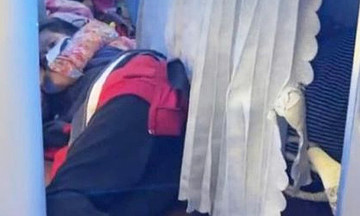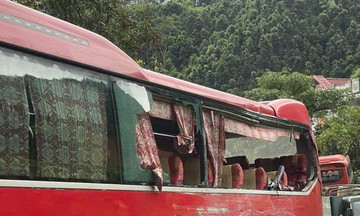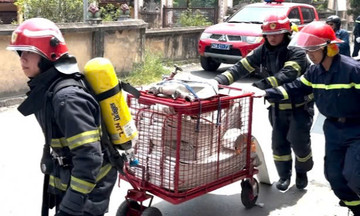According to the book "Cuba - Vietnam: Two Nations, One History" published by the National Political Publishing House, in late 1960, Cuban Deputy Foreign Minister Hector Rodriguez Llompart was assigned to visit and establish diplomatic relations with the Democratic Republic of Vietnam. Cuba was the first country in the Americas to recognize and establish diplomatic relations with Vietnam during the war.
Hoang Van Loi was appointed as Vietnam's ambassador to Cuba. Three months later, the Vietnamese government made its first official visit to the Caribbean nation, led by Minister of Culture Hoang Minh Giam. Minister Giam was warmly received by Commander-in-Chief Fidel Castro. At that time, the Vietnamese delegation required two interpreters, translating from Vietnamese to English and then from English to Spanish.
This surprised Fidel. Giam explained that no one in Vietnam at the time spoke Spanish. Fidel Castro then suggested, "With 23 Spanish-speaking Latin American countries, you should send 23 young people to Cuba to study Spanish so they can become ambassadors to these countries in the future."
Ambassador Hoang Van Loi immediately reported Fidel's proposal. The government quickly selected 23 students for the first group to study in Cuba. They were all officials and party members from key agencies such as the Ministry of Foreign Affairs, the Central Committee's Commission for External Relations, the Ministry of National Defense, the Ministry of Public Security, and the Vietnam News Agency.
In November 1961, the group of 23 students arrived in Havana to study Spanish. After completing their 3-5 year courses, most returned to work in their respective agencies, and some later became Vietnamese ambassadors to Cuba, including Do Van Tai, Deputy Head of the Central Committee's Commission for External Relations, and Le Duc Cang, Assistant Minister of Foreign Affairs.
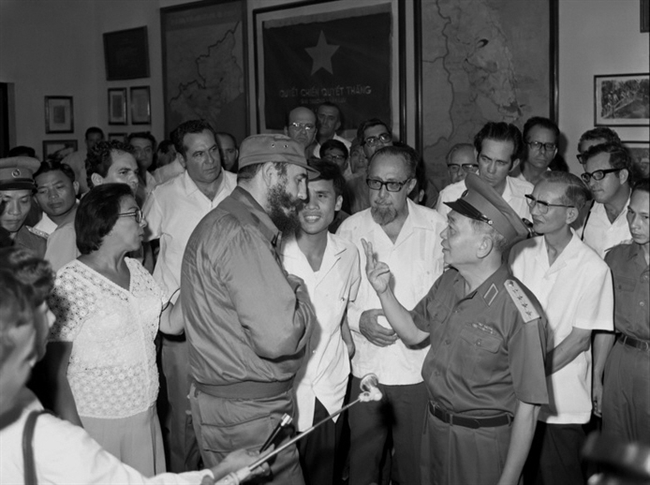 |
General Vo Nguyen Giap and Fidel Castro visiting the Vietnam Military History Museum (12/9/1973). Photo: VNA |
General Vo Nguyen Giap and Fidel Castro visiting the Vietnam Military History Museum (12/9/1973). Photo: VNA
"For Vietnam, Cuba is willing to shed its blood"
On 26/6/1965, speaking to a delegation of Cuban youth in Havana, Fidel Castro affirmed his absolute support for Vietnam—a friend on the other side of the globe—fighting for independence against American aggression. In his message to the young generation of Cuba, he repeatedly emphasized the just cause of the Vietnamese people's struggle for national reunification, and Cuba's willingness to accompany and share in that great cause.
One of his most memorable statements, etched in the memory of the two nations, was the affirmation: "For Vietnam, Cuba is willing to shed its blood." Although he repeated this statement many times, it first resonated during the 7th anniversary celebration of the Cuban Revolution on 2/1/1966 at Revolution Square in Havana.
In September 1973, Fidel Castro made his first visit to Vietnam. Amidst the midday Hanoi heat, he stepped off the IL-18 aircraft to a warm welcome from high-ranking leaders: First Secretary Le Duan, National Assembly Standing Committee Chairman Truong Chinh, Prime Minister Pham Van Dong, Deputy Prime Minister and Minister of National Defense Vo Nguyen Giap, along with numerous officials and soldiers.
Fidel's tight embraces and radiant smiles made the reunion seem like one of long-lost comrades. When Vietnamese children presented him with flowers, he bent down and kissed a child on the cheek – a deeply moving gesture. General Vo Nguyen Giap then personally escorted Fidel to the Vietnam Military History Museum. There, the legendary general pinned the "Dien Bien Phu Soldier" badge onto Fidel's chest.
During this visit, Fidel Castro also traveled to Quang Tri, standing on Hill 241, the former American base known as Carol. Before a circle of soldiers, he raised the victory flag and declared: "Thank you. Carry this victorious flag forward to final victory!" and chanted "For Vietnam, Cuba is willing to shed its blood!"
Before 1975, he was the first and only head of state to visit the liberated zone of South Vietnam. Diplomat Nguyen Xuan Phong observed that "the visit became a symbol of the loyal and close solidarity between the two peoples of Vietnam and Cuba, sharing the ideals of peace, national independence, and social progress."
Also during the Quang Tri trip, when Fidel Castro's delegation stopped on the north bank of the Ben Hai River, he witnessed three civilians injured by mines. He immediately instructed his personal physician to provide first aid and transport them in the delegation's vehicle to Vinh Linh Hospital for surgery. Even after returning to Cuba, Fidel inquired about their health multiple times.
Before leaving Vietnam, he expressed regret at not having met President Ho Chi Minh before his passing in 1969. However, he considered the meeting with General Vo Nguyen Giap a special memory. "We came to this heroic land with deep admiration and return with even greater respect. We are inspired and encouraged by the victories and extraordinary example of Vietnam," Fidel stated.
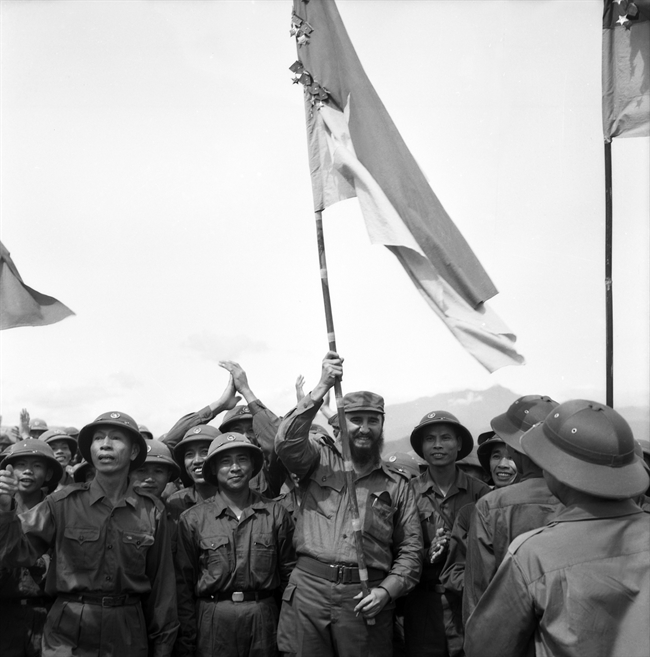 |
Cuban leader Fidel Castro waving the Liberation Army's flag at Khe Sanh Battalion during a meeting with soldiers in Quang Tri. Photo: VNA |
Cuban leader Fidel Castro waving the Liberation Army's flag at Khe Sanh Battalion during a meeting with soldiers in Quang Tri. Photo: VNA
Shoulder to shoulder in times of hardship
Following the visit to Vietnam, the Cuban government gifted the Truong Son soldiers a fleet of vehicles and modern road construction equipment worth 6 million USD. In addition, Cuba sent a team of highly skilled engineers and technicians to collaborate with the 515th Engineer Regiment in constructing Route 42 from Ben Tat to Cam Lo (Quang Tri) and upgrading Route 14 from Dakrong Bridge to A Luoi (Thua Thien Hue) starting in late 1974.
President Fidel Castro and the Cuban people also gifted Vietnam five large-scale socio-economic projects, totaling approximately 80 million USD, including: Thang Loi Hotel (Hanoi), Vietnam-Cuba Hospital (Dong Hoi, formerly Quang Binh), Xuan Mai Road, Ba Vi Cattle Breeding Farm, and Luong My Chicken Farm. These projects have become symbolic landmarks, cherished by generations of Vietnamese.
To this day, the Vietnam-Cuba Hospital continues to invite Cuban medical experts to work annually in specialized departments such as cardiology, orthopedic trauma surgery, neurosurgery, oncology, pediatrics, and gastroenterology. These highly skilled Cuban doctors have helped treat numerous complex cases.
In addition to sending doctors directly, Cuba has also provided numerous scholarships for Vietnamese students to train as doctors, pharmacists, and agricultural engineers. From the 1970s to the present, thousands of Vietnamese students have been trained in Cuba, many of whom have become leading experts in medicine, education, and science. In the medical field alone, many Vietnamese doctors who studied at the University of Medical Sciences of Havana or Camaguey Medical School have made significant contributions to the domestic healthcare sector.
From 1961 to 1975, Cuba consistently provided about 50,000 tons of sugar annually and sent doctors to care for wounded and sick soldiers. Nearly one million Vietnamese students studied in Cuba during this period, and upon their return, they made important contributions to national construction, development, and defense.
Notably, in the field of preventive medicine, Cuba provided vaccines against meningitis, polio, and tetanus for Vietnamese children in the 1980s and 1990s. Many people born in the 1970s and 1980s still bear the characteristic scars from these Cuban vaccine injections. These scars serve as a profound reminder of the humane friendship that the Cuban people have extended to Vietnam.
Associate Professor Nguyen Viet Thao, Vice President of the Ho Chi Minh National Academy of Politics and President of the Vietnam-Cuba Friendship Association in Hanoi, noted that cooperation between the two countries has expanded across various sectors, from agriculture, industry, construction, trade, and investment to culture, education, and science and technology.
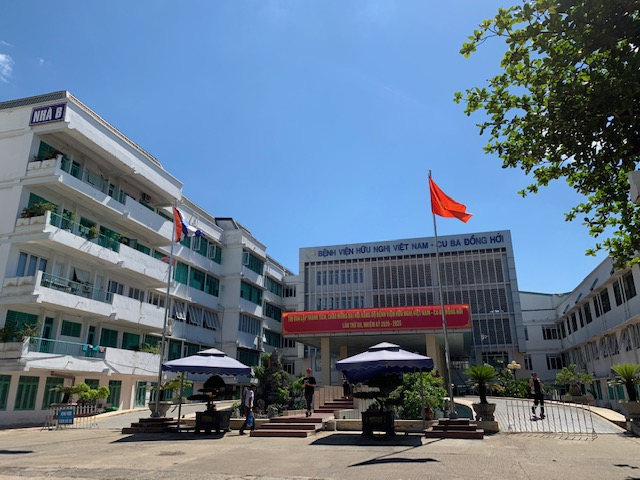 |
Vietnam - Cuba Friendship Hospital in Dong Hoi, formerly Quang Binh. Photo: VNA |
Vietnam - Cuba Friendship Hospital in Dong Hoi, formerly Quang Binh. Photo: VNA
After the collapse of the Soviet Union and the socialist bloc in Eastern Europe, Cuba fell into a severe socio-economic crisis. In 1990, its economy experienced negative growth of 2.6%; by 1993, GDP had fallen by 35% compared to 1989, and foreign debt reached about 11 billion USD, not including Russia's converted debt of 21.5 billion rubles.
Under these circumstances, Vietnam offered Cuba sincere support, considering it an obligation stemming from pure international sentiment. Vietnam firmly maintained its stance in supporting Cuba's struggle to end the economic, trade, and financial embargo. Numerous support movements were launched, including donations of 20,000 tons of rice, 5 million sets of stationery, 5,000 sets of clothing, and a day's salary from civil servants. Vietnam also sold rice to Cuba at preferential prices and implemented several agricultural and food projects, contributing to ensuring the livelihood of the Cuban people.
In March 1994, Vietnam gifted Cuba 15,000 tons of rice; in May 1995, it continued to provide an additional 20,000 tons. Cuban Ambassador to Vietnam Orlando Nicolas Hernandez Guillen affirmed, "Throughout the ups and downs of history, Vietnam and Cuba have always stood side by side, supporting each other during the most difficult times. This is a resounding testament to the special fraternal friendship between two nations half a world apart."
Even during the Covid-19 pandemic in early 2020, despite facing its own difficulties, Cuba immediately gifted Vietnam a batch of treatment drugs sufficient for 1,000 patients and sent medical experts to provide support. Cuba expressed its willingness to open two more production facilities to meet Vietnam's needs if its vaccine requirements exceeded Cuba's current production capacity.
The late Senior Lieutenant General Nguyen Chi Vinh, Deputy Minister of National Defense, recounted that when both Vietnam and Cuba were severely affected by the Covid-19 pandemic, the Vietnamese Ministry of National Defense, following the direction of the Party and State, sent a letter requesting assistance from the Ministry of the Revolutionary Armed Forces of Cuba. Vinh personally sent this letter. Just two days later, Vietnam received a response from the Political Bureau and the Ministry of the Revolutionary Armed Forces of Cuba.
"Can you believe it? Halfway around the world, and we received a response in just two days, stating that Cuba was ready to help Vietnam with everything they had. Unthinkable in today's world," General Vinh remarked.
First Secretary of the Communist Party of Cuba and President Miguel Diaz Canel stated during a meeting with the Vietnamese delegation: "Just as Fidel once expressed Cuba's willingness to shed its blood for Vietnam, today we are ready to provide and transfer Covid-19 vaccine technology to the Vietnamese people."
In July 2024, to commemorate the late General Secretary Nguyen Phu Trong, Cuba declared three days of national mourning (20-22/7). During a plenary session on 19/7, the Cuban National Assembly held a minute of silence and officially announced the national mourning period.
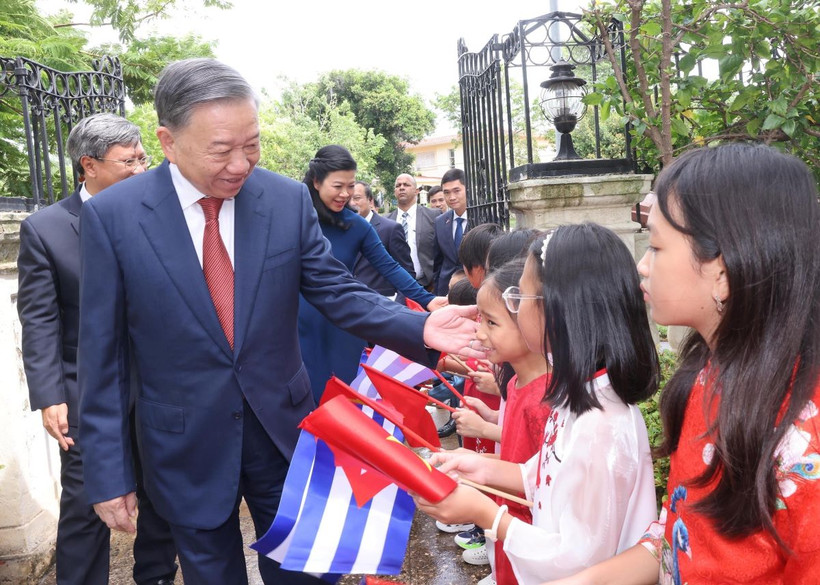 |
General Secretary and President To Lam and his wife with Vietnamese children in Cuba, September 2024. Photo: VNA |
General Secretary and President To Lam and his wife with Vietnamese children in Cuba, September 2024. Photo: VNA
During his visit to Cuba in September 2024, General Secretary To Lam (who was also President at the time) emphasized that in world history, few relationships are as special as the one between Vietnam and Cuba. This relationship is the result of decades of cultivation by revolutionary leaders Jose Marti, Ho Chi Minh, Fidel Castro, and generations of leaders from both countries.
"It is a uniquely pure, exemplary, and loyal relationship, a symbol of our time, built on connection, empathy, understanding, and the two nations' shared noble revolutionary ideals and tireless struggle for independence, freedom, and the ideals of socialism," General Secretary To Lam stated.
Vietnam is currently Cuba's second-largest trading partner and largest investor from the Asia-Pacific region. In 2021, bilateral trade reached 261.7 million USD; in 2022, it reached 181.8 million USD; and in 2023, it reached 57.33 million USD.
The Central Committee of the Vietnam Red Cross Society is currently implementing a campaign to support the Cuban people with the theme "65 Years of Vietnam-Cuba Solidarity".
Donation Information:
: Central Committee of the Vietnam Red Cross Society
: Account number: 2022, Military Commercial Joint Stock Bank (MBBank)
: Transfer content: CUBA
: Donation period: From 13/8/2025 to 16/10/2025
Son Ha








